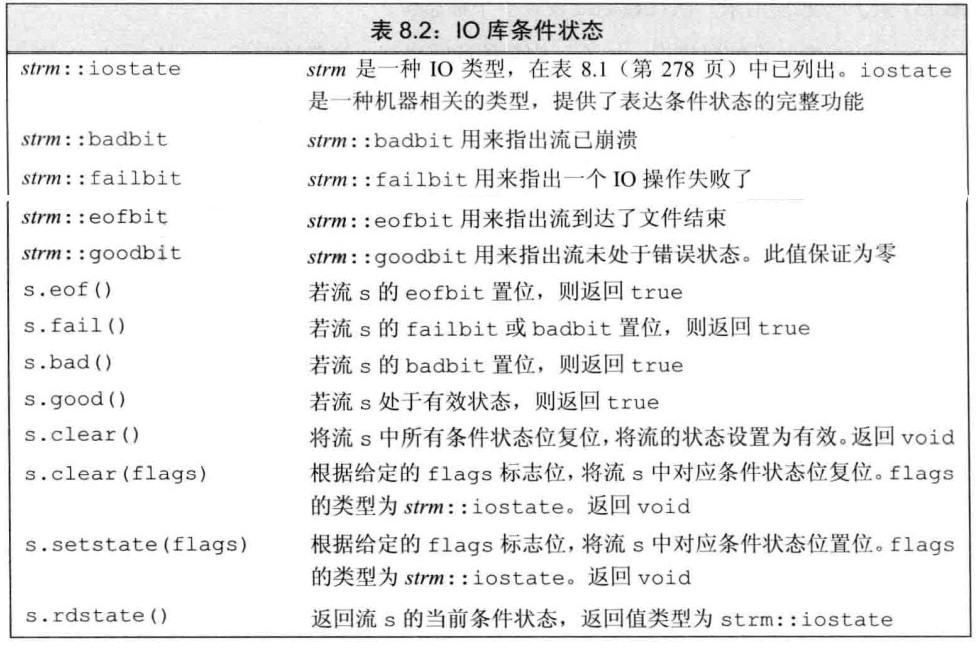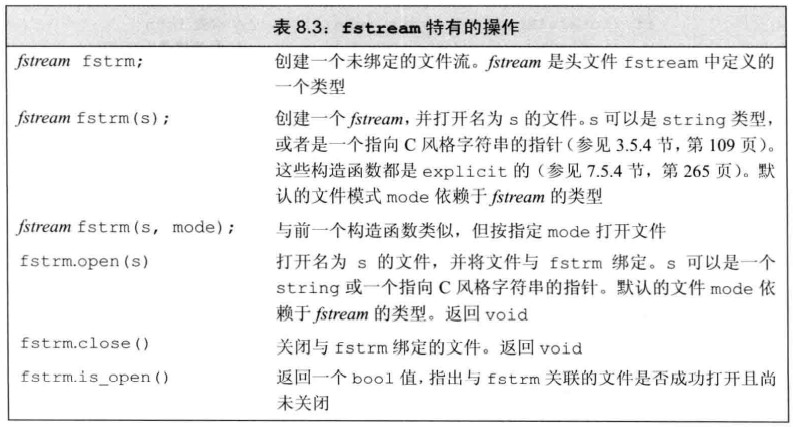IO库C++
Posted atohome
tags:
篇首语:本文由小常识网(cha138.com)小编为大家整理,主要介绍了IO库C++相关的知识,希望对你有一定的参考价值。
第8章 IO库
在本章我们只是大致了解C++中的IO库,了解相关的stream类的使用以及它们的特性与概念,关于文件操作更详细的细节将会再后面进行学习,在此不必过分要求自己必须掌握文件操作,总之与我们在此学的是C++对IO的一些封装
C++中不直接处理输入输出,而是通过一系列定义在标准库中的类型处理IO,这些类型支持从设备读取数据,向设备写入数据的IO操作,设备可以是文件,控制台窗口等
还有一些类型允许操作内存IO,即从string读取数据,向string写入数据
我们已经接触了
istream输入流类型,提供输入操作。ostream输出流类型,提供输出操作。
cin是一个istream对象,从标准输入读取数据
cout是一个ostream对象,向标准输出写入数据
cerr是一个ostream对象,通常用于输出程序错误信息,写入到标准错误
>>运算符,用来从一个istream对象读取输入数据
<<运算符,用来向一个ostream对象写入输出数据
getline函数,从一个给定的istream读取一行数据,存入一个给定的string对象中
IO类
先知道下面的东西大致有什么用途即可

以w开头的是表示支持使用宽字符的语言,C++定义类一组来操纵wchar_t类型的数据,宽字符版本类型和函数以w开头,如wcin,wcout,wcerr
//example1.cpp
#include<iostream>
using namespace std;
int main(int argc,char**argv)
wstring name;
wcin >> name;//你好
wcout << name << endl;//你好
cout << name.length() << endl;//4
return 0;
IO类型间的关系
不同的输入输出流之间只通过继承机制来实现的,所有输入流的基类都是istream,所有输出流的基类是ostream
IO对象无拷贝或赋值
总之IO对象是不能进行赋值的,因为不能拷贝,所以不能将形参或返回类型设置为流类型
通常会使用引用方式传递和返回,因为读写一个对象会改变其状态,传递和返回的引用不能是const的
条件状态
流对象有自己的状态,称为操作流的条件状态

看不懂没关系,先知道有这么回事,会面的学习才会真的用起来
//example2.cpp
#include<iostream>
using namespace std;
int main(int argc,char**argv)
cout << cin.eof() << endl;//0
cout << cin.fail() << endl;//0
cout << cin.good() << endl;//1 此时流状态位goodbit为1
std::ios_base::iostate state=std::ios_base::failbit;
cin.setstate(state);
//读取条件状态
cout << (cin.rdstate()==std::ios_base::failbit) << endl;//1
cout << (cin.rdstate()==cin.failbit) << endl;//1
cout << cin.good() << endl;//0
return 0;
实际使用
//example3.cpp
#include<iostream>
using namespace std;
int main(int argc,char**argv)
int i;
cin >> i;//g
cout << cin.good() << endl;//0
cout << i << endl;//0
cin >> i;//不会被正常执行,因为cin的状态已经发生错误
cout << cin.good() << endl;//0
return 0;
如果将流操作放入if或者while等需要进行布尔检查的地方,则会检查流的状态
//example4.cpp
#include<iostream>
using namespace std;
int main(int argc,char**argv)
int i;
if(cin>>i)
cout << i << endl;
//输入 e 输出 none
//输入 3 输出 3
return 0;
管理条件状态
读取条件状态使用rdstate()方法,使用clear()恢复默认的状态,setstate设置状态
//example5.cpp
#include<iostream>
using namespace std;
int main(int argc,char**argv)
auto old_state = cin.rdstate();
cin.clear();//恢复默认条件状态
cin.setstate(old_state);
//复位时可以保持其他标志位不变
cin.clear(cin.rdstate() & ~cin.failbit & ~cin.badbit);
//辅位failbit、badbit 保持其他标志位不变
return 0;
管理输出缓冲
每个输出流都管理一个缓冲区,用来保存程序读写的数据
os<<"hello world";
文本可能马上打印出来,也可能保存在缓冲区中,随后打印
操作系统可以将多个程序的多个输出操作组合称单一的系统级写操作,提高效率
导致缓冲刷新,即数据真正写出输出设备或文件的原因有很多
- 程序正常结束,作为main函数的return操作的一部分,缓冲被刷新
- 缓冲区满的时候
- 使用endl显式刷新缓冲区
- 每个输出操纵后,可以使用操纵符unitbuf设置流的内部状态,来清空缓冲区,cerr默认是被设置unitbuf的,因此写入到cerr的内容会马上输出
- 一个输出流可能被关联到另一个流,当读写被关联的流时,关联到的流的缓冲区会被刷新,如cin、cerr都关联到cout,因此读cin或写cerr都会导致cout的缓冲区被刷新
//example6.cpp
#include <iostream>
using namespace std;
int main(int argc, char **argv)
cout << "hello world" << endl;//输出加换行 然后刷新
cout << "hello world" << flush;//输出 然后刷新
cout << "hello world" << ends;//输出加一个空字符 然后刷新
//hello world
//hello worldhello world
return 0;
unitbuf操纵符
//example7.cpp
#include<iostream>
using namespace std;
int main(int argc,char**argv)
cout << unitbuf;
//都cout的写入都会立即刷新缓冲区,即立即输出
//即cout不再使用缓冲区
cout << "hello world";//hello world
cout << nounitbuf;//恢复使用缓冲方式
return 0;
关联输入和输出流
当一个输入流关联到一个输出流时,任何试图输入流读取数据的操作都会先刷新关联的输出流,默认cout与cin关联在一起
//example8.cpp
#include<iostream>
using namespace std;
int main(int argc,char**argv)
cout << "hello world" << endl;
int i;
cin >> i;//cout被缓冲区被刷新
//也就是形成了先输出才会等待输入
return 0;
tie()方法允许我们进行输入和输出流之间的关联
tie有两个重载一个接收输出流的指针(设置关联的输出流指针),一个没有参数(返回关联输出流的指针)
//example9.cpp
#include<iostream>
using namespace std;
int main(int argc,char**argv)
std::ostream* m_ostream=cin.tie();
if(m_ostream==&cout)
cout << "m_ostream==&cout" << endl;//m_ostream==&cout
cin.tie(nullptr);//取消与其他输出流的关联
cin.tie(&cout);//恢复关联
return 0;
文件输入输出
三种流对象支持对文件的内容操作,ifstream从一个文件读取数据,ofstream向一个给定文件写入数据,以及fstream可以读写给定文件

使用文件流对象
//example10.iofile
hello world
输入流的创建、文件打开与关闭
//example10.cpp
#include<iostream>
#include<string>
#include<fstream>
using namespace std;
int main(int argc,char**argv)
//构造一个ifstream并打开给定文件
ifstream m_instream("./example10.iofile");
//或
// ifstream m_instream;
// m_instream.open("./example10.iofile");
if(m_instream.fail()||!m_instream.good())
cout << "file open failed" << endl;
return 0;
string str;
m_instream>>str;
cout <<str.size()<<":"<< str << endl;//5:hello
m_instream >> str;
cout <<str.size()<<":"<< str << endl;//5:world
m_instream >> str;
m_instream.seekg(0);//
getline(m_instream,str);
cout << str.size()<<":"<<str << endl;//5:world
//关闭输入流
if(m_instream.is_open())
m_instream.close();
return 0;
fstream 自动构造和析构
对于fstream对象不论是栈内存对象,还是堆内存对象,当他们的离开作用域的是否,fstream的析构函数会被调用,此时close会自动调用
文件模式

只有当out被设定才能设定trunc模式
如果trunc没有被设定,可以设定app模式,在app模式即使没有显示指定out模式,文件总能以输出模式被打开
默认情况下,即使没有指定trunc,以out模式打开的文件会被截断,为了保留以out模式打开的文件的内容,必须同时指定app模式,这样才会将数据追加到末尾或同时指定in
ate和binary模式可用于任何类型的文件流对象
默认文件模式
ifstream默认使用in模式、ofstream默认使用out模式、fstream默认使用in|out模式
//example11.cpp
#include<iostream>
#include<fstream>
using namespace std;
int main(int argc,char**argv)
fstream m_stream;
//当example11.iofile不存在时会自动创建一个空文件
m_stream.open("./example11.iofile",fstream::app|fstream::in);//追加且可写
if(m_stream.fail())
return -1;
string str="hello world\\n";
m_stream << str;//写到文件中去
//m_stream.write(char*,sizt_t);
m_stream.seekg(0,ios::beg);//更改读指针的位置
// m_stream.seekp(0,ios::end);//更改写指针的位置
// m_stream.tellp();
//cout << m_stream.tellg() << endl;
//m_stream.peek()!=EOF//返回文件流中的第一个字符,但并不是提取该字符。
cout << m_stream.eof() << endl;//0
while(m_stream.good()&&!m_stream.eof())//下一个字符不是EOF
getline(m_stream, str);
cout << str<<"\\n";
cout << m_stream.eof() << endl;
m_stream.close();
return 0;
string流
sstream头文件定义了三个支持内存IO,可以向string写入数据,从string读取数据,就像string是一个IO流一样
istringstream从string读取数据,ostringstream向string写入数据,而头文件stringstream既可以从string读数据写可以写数据,同理这些类也继承iostream,可以使用iostream,istream,ostream相关的操作

使用istringstream
字符串输入流,即从流中读取数据
//example12.cpp
#include<iostream>
#include<sstream>
using namespace std;
int main(int argc,char**argv)
string str="hello world";
istringstream m_istringstream(str);//拷贝一份str作为输入流使用
string temp;
m_istringstream >> temp;//从流中读取数据
cout << temp << endl;//hello
cout << m_istringstream.eof() << endl;//0
m_istringstream >> temp;//从流中读取数据
cout << temp << endl;//world
cout << m_istringstream.eof() << endl;//1
return 0;
使用ostringstream
字符串输出流,即向字符串流写数据
//example13.cpp
#include<iostream>
#include<sstream>
using namespace std;
int main(int argc,char**argv)
string str = "hello world";
ostringstream m_ostringstream(str);
m_ostringstream << " c++";
string temp;
temp=m_ostringstream.str();
cout << temp << endl;//c++o world
m_ostringstream << "hello c++";
//返回流保存的string的拷贝
cout << m_ostringstream.str() << endl;//c++hello c++
return 0;
使用stringstream
stringstream综合了istringstream与ostringstream的功能特性
//example14.cpp
#include<iostream>
#include<sstream>
using namespace std;
int main(int argc,char**argv)
stringstream stream;
stream << "hello world";//向流写入内容
cout << stream.str() << endl;//hello world
string temp;
stream >> temp;//从流中读取内容
cout << stream.eof() << endl;//0
cout << temp << endl;//hello
stream >> temp;//从流中读取内容
cout << temp << endl;//world
cout << stream.eof() << endl;//1
return 0;
不要慌,在此学习的内容不是文件操作,如果从C语言来学C++我们的思想要逐渐学习面向对象的思想,C++向我们提供了强大的IO流的操作的封装,这使得开发更加便捷,使用得当代码也能得到较好的维护性
以上是关于IO库C++的主要内容,如果未能解决你的问题,请参考以下文章